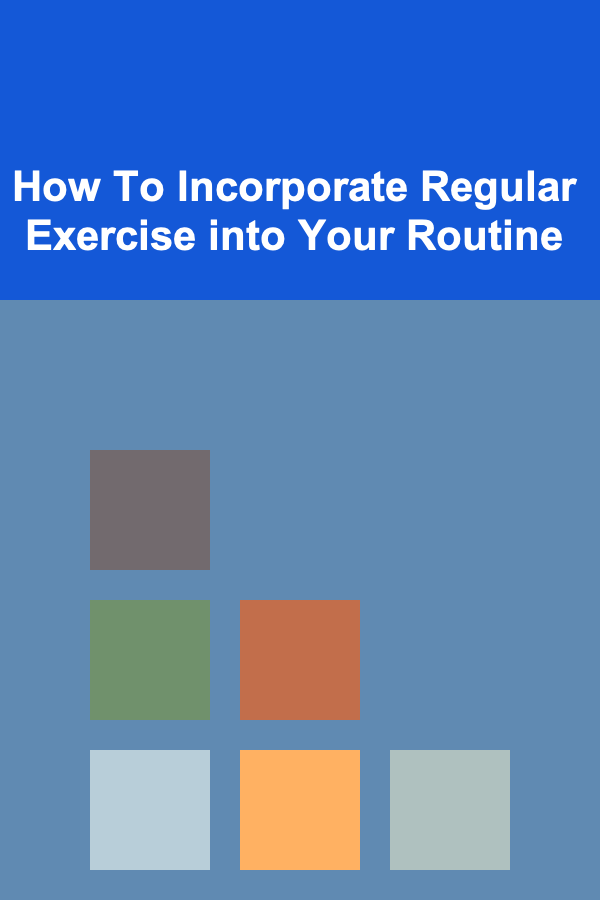
How To Incorporate Regular Exercise into Your Routine
ebook include PDF & Audio bundle (Micro Guide)
$12.99$10.99
Limited Time Offer! Order within the next:

Incorporating regular exercise into your routine is one of the most effective ways to improve your overall health and well-being. Whether you're looking to lose weight, build muscle, improve cardiovascular health, or simply feel better day to day, regular physical activity is crucial. However, finding the time and motivation to exercise regularly can be challenging. In this article, we'll discuss how you can successfully integrate exercise into your daily life, the benefits of regular physical activity, and how to create a sustainable routine that fits into your unique lifestyle.
The Importance of Regular Exercise
Before diving into how to incorporate exercise into your routine, it's important to understand why regular physical activity is so essential. The benefits of exercise extend beyond just weight loss or muscle gain -- they contribute to better mental health, increased energy levels, and a reduced risk of chronic diseases.
Physical Health Benefits
- Improves Cardiovascular Health: Regular exercise strengthens the heart and improves circulation, reducing the risk of heart disease, stroke, and high blood pressure.
- Enhances Muscle and Bone Strength: Weight-bearing exercises help build muscle mass and increase bone density, reducing the risk of osteoporosis as you age.
- Aids Weight Management: Exercise helps burn calories, boost metabolism, and regulate hormones, all of which contribute to maintaining or achieving a healthy weight.
- Boosts Immune System Function: Regular physical activity can help strengthen the immune system, making you less susceptible to illness and infection.
- Improves Flexibility and Balance: Stretching, yoga, and other exercises improve flexibility, which can enhance mobility and balance, reducing the risk of falls, especially in older adults.
Mental Health Benefits
- Reduces Stress and Anxiety: Physical activity triggers the release of endorphins, the body's natural mood lifters, which can help reduce stress and anxiety levels.
- Improves Sleep Quality: Regular exercise can improve the quality of your sleep, helping you fall asleep faster and enjoy a deeper, more restful night's sleep.
- Boosts Mood and Cognitive Function: Exercise has been shown to improve mood, reduce feelings of depression, and even enhance cognitive function, leading to better focus, memory, and mental clarity.
Longevity and Quality of Life
- Increases Lifespan: Studies have shown that those who exercise regularly tend to live longer lives. Physical activity can delay the onset of age-related conditions and improve the quality of life in later years.
- Enhances Functional Independence: Regular exercise helps maintain physical strength, mobility, and flexibility, which are vital for independent living as you age.
Understanding the Barriers to Exercise
Despite the numerous benefits, many people find it challenging to exercise regularly. Some of the most common barriers include:
Lack of Time
One of the most frequently cited reasons for not exercising is a perceived lack of time. With busy work schedules, family obligations, and other responsibilities, fitting in exercise can seem impossible.
Lack of Motivation
It can be hard to find the motivation to exercise, especially when you're just starting or when you're faced with competing interests and distractions.
Physical Limitations
For some individuals, physical limitations or health conditions can make exercise seem daunting or even unsafe. Whether it's due to chronic pain, injury, or other health concerns, it can feel overwhelming to begin an exercise routine.
Lack of Knowledge
Not everyone knows where to start when it comes to exercise. With so many different workout options available -- from gym routines to yoga to outdoor activities -- it's easy to feel confused or unsure of what type of exercise will be most effective for you.
How to Overcome Barriers and Incorporate Exercise into Your Routine
Now that we've discussed the importance of exercise and some common barriers, let's explore how to overcome these obstacles and make exercise a consistent part of your daily routine.
1. Set Realistic Goals
One of the most important steps in incorporating exercise into your routine is setting realistic, achievable goals. Rather than aiming for drastic results in a short period, focus on small, incremental changes that you can maintain long-term.
SMART Goals
To set effective exercise goals, consider using the SMART framework:
- Specific: Be clear about what you want to achieve (e.g., "I will exercise for 30 minutes, three times per week").
- Measurable: Track your progress by measuring frequency, duration, or intensity.
- Achievable: Set goals that are challenging yet realistic based on your fitness level.
- Relevant: Make sure your goals align with your personal health and fitness objectives.
- Time-bound: Set a timeframe for your goals to keep yourself on track (e.g., "I will exercise three times a week for the next month").
2. Find an Activity You Enjoy
It's much easier to commit to a regular exercise routine if you enjoy the activity. Experiment with different types of exercise until you find something you like. This could be running, cycling, dancing, swimming, strength training, or yoga. Even activities like hiking, walking, or playing a sport can provide great cardiovascular and strength benefits.
When you find an activity that feels fun, it no longer becomes a chore. You'll be more likely to stick to your routine and even look forward to your workouts.
3. Schedule Exercise Like an Appointment
A key strategy for overcoming the "lack of time" barrier is to treat exercise like an important appointment. Put it on your calendar just as you would any work meeting or social engagement. Make it a non-negotiable part of your daily routine.
It may help to choose a time that works best for you -- whether that's early in the morning, during lunch breaks, or in the evening after work. The key is consistency; by scheduling it regularly, it becomes a habit.
4. Start Small and Gradually Increase Intensity
If you're new to exercise, it's important to start slow and gradually increase the intensity of your workouts. This will help prevent injury, improve your fitness level over time, and keep you motivated as you see progress.
Start with shorter sessions, such as 10-15 minutes of exercise, and gradually increase the duration and intensity as your fitness improves. You can also alternate between different types of exercise to keep things interesting and avoid burnout.
5. Make Exercise Social
Another way to stay motivated and accountable is to exercise with a friend, family member, or workout buddy. Exercising with others can make it more enjoyable and create a sense of community. You can also motivate each other and keep each other on track.
If you don't have anyone to exercise with, consider joining a fitness class, sports team, or online exercise group. Many people find that being part of a community helps them stay consistent and committed to their fitness goals.
6. Use Technology and Fitness Apps
Technology can be a powerful tool for incorporating exercise into your routine. There are many fitness apps, tracking devices, and online workout programs available that can help you stay on track and reach your goals.
Fitness apps often allow you to set goals, track progress, and follow workout plans tailored to your needs. You can also join online fitness challenges or virtual races to keep things fun and motivating. Wearable fitness trackers, such as Fitbit or Apple Watch, can monitor your activity levels and remind you to move throughout the day.
7. Incorporate Movement into Your Daily Life
Exercise doesn't always have to involve going to the gym or completing a structured workout. You can incorporate physical activity into your daily life in simple, effective ways.
- Walk or cycle to work: If possible, try walking or cycling to work instead of driving. This can add extra steps to your day and boost your cardiovascular health.
- Take the stairs: Skip the elevator and take the stairs whenever possible.
- Take active breaks: If you have a sedentary job, take breaks to walk around or do a few stretches.
- Engage in household chores: Vacuuming, mopping, and gardening can all provide physical activity and contribute to your fitness.
8. Listen to Your Body
It's essential to listen to your body and avoid pushing yourself too hard, especially in the beginning. If you feel pain or discomfort, take a break and reassess your routine. Over time, your body will adjust to regular exercise, and you'll build the endurance and strength needed to handle more challenging workouts.
Be sure to rest when necessary, stay hydrated, and incorporate proper warm-ups and cool-downs into your routine to prevent injuries.
9. Reward Yourself
Finally, don't forget to celebrate your successes along the way. Set milestones and reward yourself for achieving them. This could mean treating yourself to a massage, buying new workout gear, or enjoying a healthy treat after a challenging workout. Rewards help reinforce positive behavior and keep you motivated to continue exercising regularly.
Conclusion
Incorporating regular exercise into your routine doesn't have to be a daunting task. With the right mindset, realistic goals, and a bit of planning, you can make exercise an enjoyable and sustainable part of your life. The benefits of regular physical activity are far-reaching, affecting not only your physical health but also your mental well-being and quality of life. By overcoming barriers, finding enjoyable activities, and creating a routine that works for you, you'll be on your way to a healthier, happier, and more active life.

How to Design a Custom Closet Storage System on a Budget
Read More
How to Prepare for Baby's First Bath: Must-Have Products
Read More
How to Tackle Seasonal Deep Cleaning Projects
Read More
How to Use Social Media Wisely in a Professional Environment
Read More
Unlocking Operational Success: A Comprehensive Guide for Chief Operating Officers
Read More
How To Start Snowkiting: Kitesurfing on Snow
Read MoreOther Products

How to Design a Custom Closet Storage System on a Budget
Read More
How to Prepare for Baby's First Bath: Must-Have Products
Read More
How to Tackle Seasonal Deep Cleaning Projects
Read More
How to Use Social Media Wisely in a Professional Environment
Read More
Unlocking Operational Success: A Comprehensive Guide for Chief Operating Officers
Read More